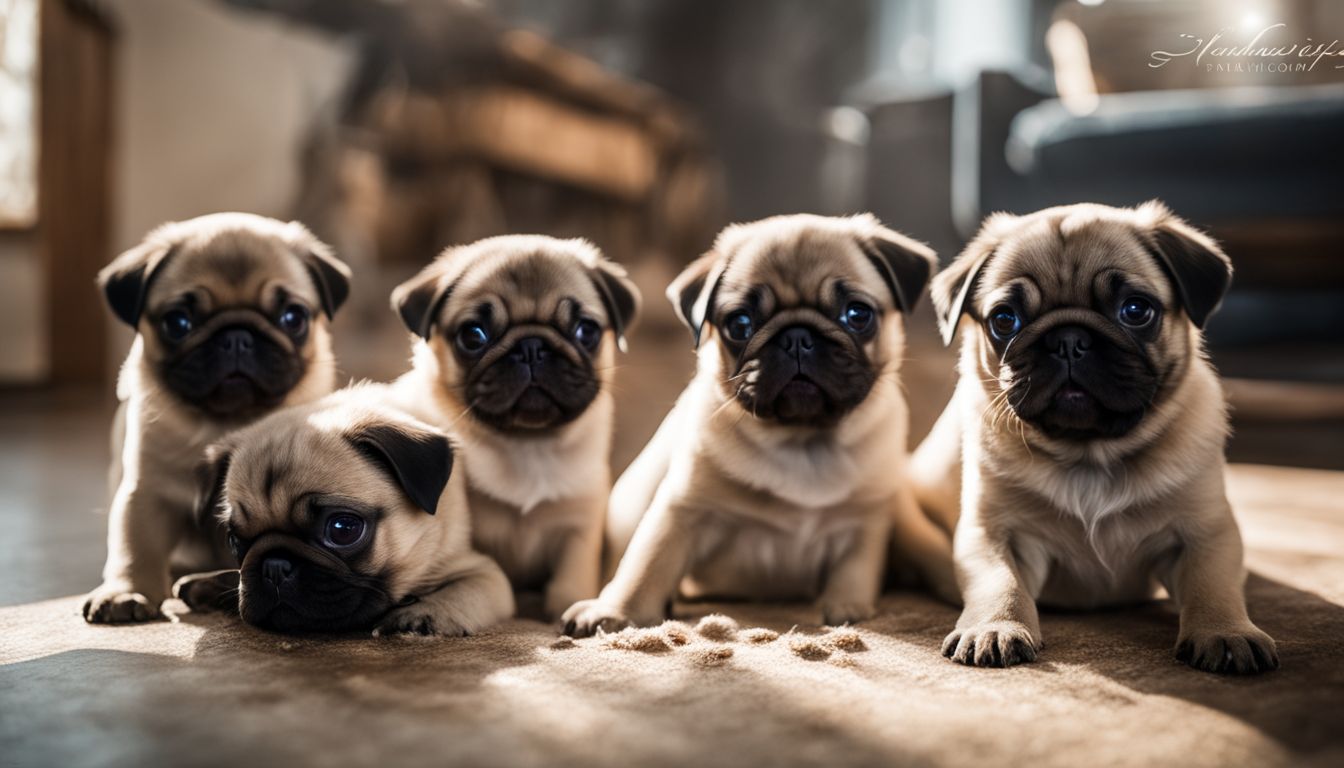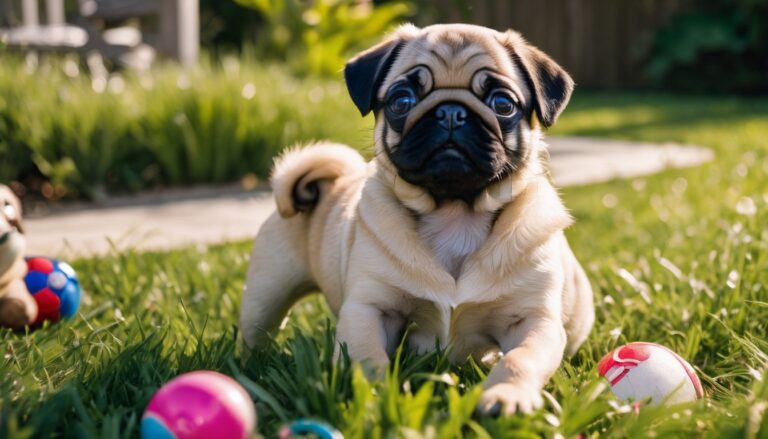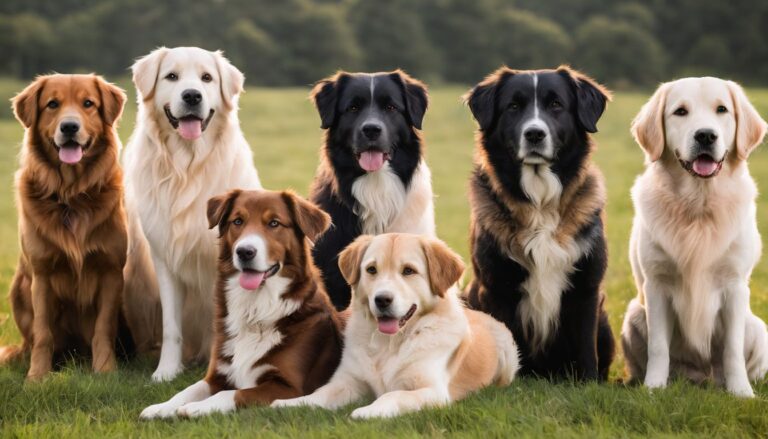Pug Breeding Tips: Maximizing Success And Ensuring The Health Of Your Pugs
Pug Breeding Tips
Breeding pugs brings immeasurable fulfillment, as it’s not only about cherishing the essence of this endearing breed but also experiencing the wonder of creating new life. Whether you’re looking to deepen your bond with these companionable dogs or potentially explore financial rewards, each step in the journey offers its own unique joys and satisfactions.
The satisfaction of continuing a beloved breed
Breeding our beloved pugs comes with a deep sense of fulfillment. We’re not just nurturing pets; we’re preserving a legacy that has brought joy to countless families and individuals throughout history.
By carefully selecting mates and prioritizing the health of these companion animals, we ensure the lineage remains strong and thriving for future generations to enjoy.
Caring for pugs as they reproduce is an experience filled with wonder. Watching new puppies take their first breaths sparks an unparalleled feeling in us, knowing we’ve contributed positively to the breed’s story.
Our efforts go beyond love for individual dogs; it’s about dedication to maintaining the unique qualities that make pugs so special in our hearts and homes.
Potential financial gain
Breeding pugs can be a lucrative venture if done responsibly. As we nurture and care for our pugs, ensuring they’re healthy and well-groomed, their puppies may attract the attention of potential buyers looking for quality pets.
We must keep in mind that sales should not compromise the well-being of these dogs. It’s important to prioritize proper weight management and overall health care, which ultimately contributes to producing pups that are not just adorable but also robust and vigorous.
Our financial success hinges on how well we manage the breeding process—from selecting the right stud dog to screening each puppy’s new owner. High standards often equate to higher demand; hence responsible breeding practices ensure we can offer puppies whose value reflects their pedigree and optimal health as certified by reputable organizations like the American Kennel Club.
Pug lovers appreciate transparency and ethical treatment of animals, which means doing things with integrity can also strengthen our reputation as breeders, potentially increasing our earnings over time without ever sacrificing the love and respect we have for every pug under our care.
Bonding with your pugs
As we breed pugs, the moments spent with these affectionate dogs strengthen our connection to them. We discover their unique personalities and quirks that separate one pug from another.
While they may not be high-energy canines, consistent training and socialization are key to forming a lifelong bond. Whether it’s an evening walk or cuddling on the couch, these activities foster a deep relationship between us and our furry friends.
We know all too well that health is foundational for any strong bond—especially so as we nurture each of our pugs into potential loving parents themselves. Regular grooming is essential; despite their short coat, pugs shed consistently and need daily attention to maintain both their appearance and comfort.
Ensuring they get adequate exercise ties directly into keeping them at a healthy weight—a crucial aspect for breeding success. Our shared experiences lead us not only towards creating happy new generations but also enhance the intelligence and cognitive abilities of each cherished dog in our care.
Ready to take on responsible breeding practices? Let’s discuss how finding a reputable breeder plays a pivotal role in ensuring the health of your pets moving forward.
Responsible Breeding for the Health of Your Pugs

Responsible breeding goes beyond the love for Pugs; it’s a commitment to their health and future. We prioritize ethical practices that safeguard our Pugs against genetic issues, ensuring they live long, happy lives.
Finding a reputable breeder
As we venture into breeding our pugs, let’s seek breeders who prioritize health and happiness. Reputable pug breeders are key to guaranteeing our dogs’ well-being and their litter’s potential.
Look for breeders who perform consistent genetic testing and health screenings; these steps are crucial for avoiding common health issues that can plague pugs if not addressed properly beforehand.
They should willingly provide proof of the care and attention they’ve given to their stud dogs and bitches, ensuring a lineage free from preventable diseases like brucellosis.
We want to work with pug breeders who share our dedication to this unique class of dog—those who understand the importance of proper weight management, socialization, and regular grooming in producing top-notch pugs.
The right breeder will also offer guidance on how to maintain these standards for any puppies we plan to bring into the world. By partnering with ethical professionals committed to the highest breeding practices, we reinforce our commitment as caretakers of this beloved breed, making certain each male or female puppy is set on a path toward a healthy life surrounded by love and care.
Ensuring genetic testing and health screenings
Genetic testing and health screenings are crucial steps in responsible pug breeding. We prioritize these measures to protect the wellbeing of our beloved dogs and to foster a healthy lineage.
- Schedule regular vet checkups for your pug to monitor its overall health.
- Test for common genetic disorders before breeding, including PDE (Pug Dog Encephalitis) and hip dysplasia.
- Conduct a complete physical examination of both male and female pugs before mating to ensure they’re fit for reproduction.
- Watch out for signs of brachycephalic syndrome, common in short-snouted breeds, which can impact breathing.
- Utilize DNA tests available to identify potential hereditary conditions your pug might carry.
- Choose a reputable breeder who understands the importance of genetic diversity to prevent inbreeding-related issues.
- Ensure both male and female pugs have certifications from recognized veterinary bodies confirming their good health status.
- Keep track of each pug’s medical history and share this information with veterinarians and potential breeders to support informed breeding decisions.
- Investigate any unusual symptoms or behaviors in your pugs as these may indicate underlying health problems that should be addressed before breeding.
- Invest time in researching your pug’s pedigree deeply, looking for any recurrent health challenges that could affect future litters.
- Acknowledge that spaying or neutering can be beneficial for preventing certain health concerns and consider these options if not planning to breed your pet.
Waiting for your pug to reach maturity
Patience is key in breeding, especially when you’re waiting for your pug to fully mature. Male pugs typically reach sexual maturity around six months, but for the health and well-being of both the stud dog and future puppies, it’s best to wait until they are at least 18-24 months old.
This gives them ample time to develop physically and mentally, ensuring they can produce happy and healthy offspring.
During this growth period, focus on providing consistent training and socialization for your pug. They may not be high-energy dogs, yet engaging daily activities are crucial for their physical health and cognitive development.
Regular grooming also helps manage their shedding coat while maintaining good hygiene—a must before considering any breeding prospects.
Tips for Successful Breeding
To maximize your success in pug breeding, it’s essential to understand and implement key strategies that take both color genetics and physical conformation into account – continue reading to discover how these factors can make a significant difference.
Understanding color genetics
Color genetics can seem complex, but it’s a key part of breeding healthy and beautiful pugs. We dive into the genes that determine their coat colors and patterns, so we can plan breedings with a clear picture of potential outcomes.
Each pug inherits color traits from both parents, which mix in unique ways due to dominant and recessive genes. For instance, fawn and black are common colors in pugs; understanding how they pass these colors on helps us predict the look of future litters.
By grasping this genetic puzzle, we ensure our beloved pugs not only charm with their appearance but also stay true to the breed standards. It’s one piece in crafting a comprehensive approach toward responsible dog breeding that prioritizes our dogs’ health above all else.
Next up, we’ll explore considering size and conformation—key factors for maintaining the integrity of the breed as we continue our journey through successful pug breeding practices.
Considering size and conformation
Just as understanding color genetics is key to breeding the pug that meets your desires, giving attention to size and conformation is essential to ensure you are nurturing true representatives of the breed.
We know our beloved pugs have a unique look – they’re compact, muscular dogs with distinctive wrinkled faces and curled tails. Breeding with an eye for these traits guarantees we help maintain what makes pugs so special.
We focus on pairing males and females that not only show off these classic features but also complement each other’s build. A stud dog might be chosen to enhance his mate’s body shape or improve upon specific characteristics in their offspring.
In doing this, we strive for puppies that are healthy, happy, and reflect the best qualities of their parents. It’s all about finding a harmonious match between two well-proportioned pugs so their puppies can embody both beauty and vigor – because after all, we’re passionate about ensuring our little companions lead joyful lives alongside us.
Utilizing available resources (such as PetMeetly) for finding a suitable mate
We know finding the perfect match for your pug can sometimes feel like looking for a needle in a haystack. That’s where online platforms like PetMeetly come into play, simplifying the search by connecting breeders and owners who share our passion for healthy pug breeding.
These resources are invaluable in bringing together pedigrees that enhance the breed’s characteristics, steering clear of common health issues, and keeping genetic diversity thriving.
Careful selection is key to ensuring our beloved dogs contribute positively to the pug population. With tools at your fingertips, you’ll find a stud dog or breeding female who meets all your criteria – from temperament to health screening results.
Now that we’ve covered finding a suitable mate through modern means, let’s turn our focus on preparing for mating and fertility to ensure successful pairing and offspring vitality.
Preparing for Mating and Fertility
In our journey of breeding pugs, a pivotal step is preparing for mating and fertility; this requires not only understanding the signs that indicate a female is ready to mate, but also timing the process precisely for optimal success.
Factors such as health status, age, and even environmental conditions play crucial roles in influencing fertility, making knowledge and preparation key components in achieving a healthy pregnancy.
Signs of a receptive female
As pug enthusiasts, we know the importance of recognizing the right time for breeding our beloved pets. Identifying signs of a receptive female pug is essential for successful mating and ensuring the continuation of healthy generations.
- Look out for behavioral changes; your usually calm and composed female may become unusually affectionate and solicit attention more frequently.
- Monitor for physical signs including a swollen vulva and light bleeding, which indicate heat is approaching, signaling her readiness to mate.
- Pay attention to her tail position; when receptive, she may hold her tail to the side, making it easier for a male dog to approach.
- Watch her interactions with male dogs; if she’s ready, she will be more tolerant of their presence, often standing still or playfully engaging with them.
- Keep an eye on scent marking; your female might start urinating more frequently around your yard to signal her availability to males.
- Notice if there’s a decrease in aggressive behavior towards male dogs as this can signify that she’s entering the optimal time frame for breeding.
- Observe changes in appetite; some females may eat less during their heat cycle.
- Detect fluctuations in her body temperature; a slight drop can occur just before ovulation.
Importance of timing for successful mating
Knowing when your female pug is receptive is vital, but timing the actual mating plays an equally critical role in breeding success. Mating at the right moment increases the chances of conception and can lead to a healthy litter of puppies.
We need to watch for signs that our pugs are ready and align this with expert knowledge on canine reproduction cycles.
Correctly timing the release of eggs from the ovaries comes down to understanding your dog’s heat cycle. This often means being patient and observant, as every pug is unique, and their cycles can vary slightly.
It’s essential we ensure our beloved pets are physically prepared for mating; they should be mature enough and in good health to handle both pregnancy and rearing puppies successfully.
Factors that can affect fertility
Several factors can play a role in the fertility of our pugs, and as dedicated breeders, we must be aware of them. Age is a significant factor; pugs should reach maturity before breeding to ensure their well-being and the health of the potential puppies.
Overbreeding or breeding dogs too young can lead to complications for both mother and litter. Nutrition also plays an essential part; pugs need a balanced diet to maintain proper weight management since obesity can lead to reduced fertility in both males and females.
Health concerns like canine herpes can seriously impact fertility, so it’s crucial for our stud dog or female to undergo regular vet checks and genetic screenings for any hereditary conditions that could affect breeding success.
Additionally, stress from environmental changes or illness may alter normal reproductive cycles. Also consider external influences like exposure to toxins or chemicals—we want no harm coming their way that could disrupt the delicate balance required for successful conception.
Careful attention helps us ensure that every step we take fosters the best possible outcome: healthy siring from parents who are at their peak state of wellbeing leads us towards rearing purebred dogs with all the loveable traits characteristic of best-of-breed pugs while safeguarding against common health issues associated with irresponsible mating practices.
Caring for Your Pregnant Pug
As pug lovers, we understand the importance of providing optimal care during pregnancy. Caring for your pregnant pug means attentively monitoring her health, ensuring she receives balanced nutrition and the right amount of exercise to support both her well-being and that of the puppies she’s carrying.
Proper nutrition and exercise during pregnancy
Ensuring your pregnant pug gets the right nutrition significantly affects both her health and the puppies’ development. A balanced diet rich in essential nutrients supports the growth of healthy pups and maintains your pug’s energy levels.
It’s important to adjust meal portions as pregnancy progresses, providing enough calories to nurture the growing litter while avoiding excessive weight gain that could cause complications.
Gentle exercise is also crucial; daily walks keep her muscles strong and improve circulation, which is vital for a smooth delivery.
As she nears whelping, closely monitor her condition, looking out for any signs of distress or discomfort. This vigilant care sets the stage seamlessly into preparing for whelping – our next crucial step towards welcoming new life into the world responsibly.
Duration of Pregnancy in Pugs
Pug pregnancies, much like our human counterparts, last for about 63 days from conception. This can vary slightly depending on the individual dog but typically falls within a range of 58 to 68 days.
As we prepare our pugs for motherhood, it’s critical to provide them with balanced nutrition and regular veterinary check-ups. Good health during pregnancy supports both the soon-to-be mama pug and her puppies.
Monitoring your pregnant pug is also essential as their due date approaches. Signs of labor may become evident as she begins nesting or acting restlessly—this is when our attention and care are most needed.
It’s just one step in ensuring that we’re ready for the exciting moment when new life arrives, which naturally leads us to gear up for whelping—a crucial stage where preparation meets anticipation.
Monitoring for complications
As the weeks progress and our pug’s pregnancy advances, we must be vigilant in watching for signs of distress or unusual symptoms. Stay alert for any changes in behavior, appetite, or energy levels that could signal a problem.
Regular checkups with the vet are crucial to catch any complications early on. These visits can also reassure us that our beloved pug is maintaining good health throughout her pregnancy.
It’s essential to have a keen eye out for issues such as difficulty breathing or excessive fatigue during this critical time. Pugs already have a unique set of respiratory challenges due to their flat faces, so special attention should be given if these conditions seem exacerbated.
We’re responsible for ensuring they get immediate care if there’s even the slightest indication of trouble because timely intervention can make all the difference for both mother and puppies’ well-being.
Preparing for whelping
Preparing for the birth of pug puppies is an exciting and serious commitment. We need to make sure everything is set for a safe delivery and that the needs of the mother and her litter are fully met.
- Research what signs indicate your pregnant pug is getting ready to give birth, such as restlessness or nesting behavior.
- Create a comfortable whelping box where she can deliver her puppies safely; it should be large enough for her to move freely but with low sides so she can see out and you can assist if necessary.
- Line the whelping box with soft, easily washable blankets or towels for comfort and warmth.
- Keep the room at a warm temperature because newborn pups cannot regulate their body heat for the first few weeks.
- Have your veterinarian’s contact information readily available in case of emergencies during delivery.
- Stock up on supplies such as clean towels, scissors with rounded tips for cutting umbilical cords, iodine for disinfecting, and a suction bulb to clear puppies’ airways if needed.
- Ensure you have a kitchen scale handy to weigh each pup after birth; tracking their weight is important for monitoring health and growth progress.
- Familiarize yourself with how to help with puppy delivery, like how gently assist a pup who is having trouble during birth without causing harm or stress to both mother and newborns.
- Stay attentive yet calm throughout the whelping process; your presence should be reassuring but not intrusive to the mother pug.
- Maintain cleanliness around the whelping area before, during, and after birth by regularly replacing dirty bedding materials with fresh ones.
Puppy Placement – Ensuring a Successful Future
When it comes to placing your pug’s puppies in new homes, the focus should be on securing a happy and prosperous future for each little one. It requires meticulous screening of potential owners, understanding the milestones of pug growth and development, ensuring proper nutrition from the get-go, and offering unwavering support to new pug parents to foster a sense of responsible ownership.
Screening potential owners
We understand the significance of placing our beloved pug puppies into caring and responsible homes. Selecting the right owners is as crucial as breeding healthy puppies, ensuring they lead happy lives.
- Assess prospective owners’ understanding of pug health needs. Inquire about their knowledge regarding regular grooming, daily activity requirements for pugs, and their approach to weight management.
- Discuss spay and neuter beliefs early on. Make sure future owners are informed about the benefits of these procedures for their pug’s well-being.
- Check for a suitable living environment. Pugs thrive in loving homes that can provide enough space and a comfortable setting.
- Inquire about previous pet experiences. Owners with prior experience might be more prepared to handle the unique personalities and needs of pugs.
- Provide information on potential health problems common in pugs. Ensuring new owners are aware of these issues helps them commit to proper care and vet visits.
- Look for signs of genuine affection towards animals. Encourage interaction between the prospective owner and the puppies to observe their chemistry.
- Ask about long – term plans for puppy care. Potential owners should have a clear strategy for taking care of their pug throughout its life.
- Explain the cognitive abilities of pugs. Educate potential owners on how consistent training and socialization contribute to their intelligence.
- Establish an open line for future support and advice. Let new owners know you’re available to answer questions or offer guidance as their puppy grows.
Pug Growth and Development
Once you’ve selected the right families for your puppies, it’s time to focus on their growth and development. Pugs are not high-energy dogs, but they still need consistent training and socialization from a young age.
These early experiences shape their unique personalities and ensure that they grow into well-adjusted adults. It’s essential for us as breeders to monitor their progress closely, especially during the critical first few months.
The proper nurturing of pug puppies goes beyond love and attention; it includes managing their diet for optimal health and monitoring their weight carefully. A pug’s development can be stunted by both underfeeding and overfeeding, so maintaining a balanced feeding schedule is crucial.
Regular grooming helps manage shedding, keeping those short coats healthy while also providing an opportunity to check for any signs of skin issues or other health concerns that might arise as your pugs grow.
What to Feed a Pug Puppy
Feeding a pug puppy the right food is critical for their growth and development. Pug puppies need a balanced diet that’s high in quality proteins, fats, and essential nutrients to help them grow into healthy adults.
We should choose a specially formulated puppy food that supports their energy levels without leading to weight gain, as proper weight management is crucial for this breed. Small kibble sizes are easier for their tiny mouths to handle, making feeding time both manageable and enjoyable.
As they grow, our pug puppies will require consistent adjustment in their diet portions based on activity level and health needs. It’s important we provide fresh water at all times and stick to a regular feeding schedule to establish good eating habits early on.
High-energy treats can be useful during training sessions but remember not to overdo it; moderation is key! Ensuring a nutritious start sets the stage for our puppies’ long-term well-being and happiness.
Providing necessary information and support
As we navigate the journey of breeding pugs, we understand the importance of offering new owners all the guidance they need. This means providing a detailed packet that includes feeding instructions, health records, and tips on training and socialization specific to this delightful breed.
We take pride in educating others on how to maintain daily activity routines for their pug’s optimal health, crucial for their cognitive abilities and overall well-being.
Moreover, our role extends beyond just handing over a puppy; it’s about ongoing support. We encourage new owners to reach out with any questions on grooming or weight management so that these beloved dogs can thrive in their new homes.
Our commitment is to ensure every adorable pug receives the best care through informed and loving ownership.
Placing puppies in loving homes
Our goal is always to ensure our pug puppies find homes where they’ll receive the love, care, and attention they deserve. We screen potential owners carefully because we believe that every pug should be part of a family that understands their unique personality and needs.
It's about matching the right puppy with the right person to foster a bond for life.
We provide new owners with all the necessary information on how to care for their little companions, from proper weight management to regular grooming. By educating them on these important aspects, we promote happy and healthy lives for each pup.
A well-cared-for pug is smarter, happier, and more connected with its family; this starts as soon as they step paw into their new home.
Pug Breeding Tips Conclusion
As we’ve explored the finer points of pug breeding, remember our ultimate aim is to nurture healthy and joyful pups. We unite in this rewarding journey, armed with knowledge and a deep affection for our four-legged friends.
Let’s step forward with confidence, applying these valuable tips to foster a brighter future for every pug pup we bring into the world. Embrace responsible breeding practices and watch as your efforts blossom into thriving pug families that will fill homes with happiness and love.
Together, let’s continue to uphold the legacy of this cherished breed with each new litter we lovingly raise.
Pug Breeding Tips FAQs
1. What should I consider when choosing a stud dog for breeding pugs?
When selecting a stud dog, aim to maximize success by looking for traits that complement your pug, like those found in popular sire breeds such as the English Bulldog or Boston Terriers.
2. How can I ensure the health of my pugs during breeding?
It’s crucial to monitor for issues common in small breeds; crossbreeding with healthier dogs, like a Dandie Dinmont Terrier or Golden Retriever, may help reduce genetic problems such as inbreeding complications.
3. When is the right time to breed my female pug after she releases her eggs from the ovaries?
Track her cycle carefully and consult with a vet to identify the optimal time post ovulation release for successful mating and healthy pups.
4. Are there risks associated with breeding related pugs too closely?
Yes, Pekinese are closely akin to similar-sized dogs—like French Bulldogs or Black Labs—but beware: overly tight gene pools can lead to amplified health issues due to rampant line-breeding practices among them.
5. Can cooperation between breeders improve my pug’s breeding outcomes?
Engaging in cooperative breeding offers an exchange of best-of-breed practices and introduces fresh bloodlines which could enhance genetics and decrease transmission risk of diseases like herpes virus affecting puppies’ early stages.







